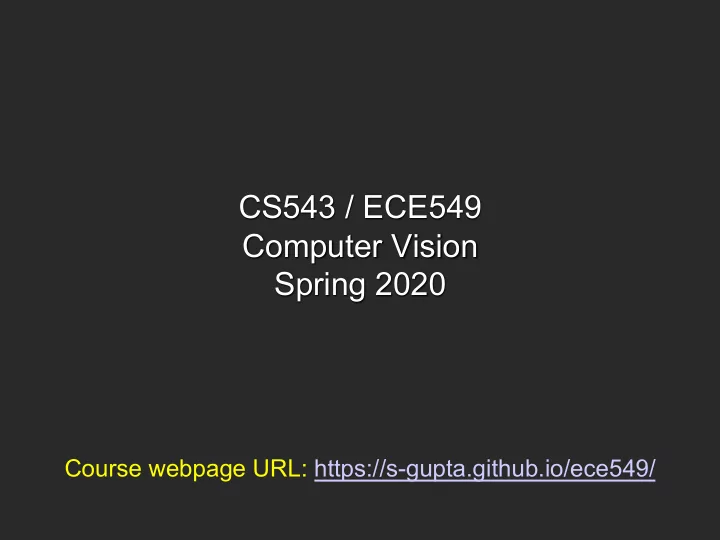

CS543 / ECE549 Computer Vision Spring 2020 Course webpage URL: https://s-gupta.github.io/ece549/
The goal of computer vision • To extract “meaning” from pixels What we see What a computer sees Source: S. Narasimhan
What kind of information can be extracted from an image? … Source: L. Lazebnik
What kind of information can be extracted from an image? … Geometric information Source: L. Lazebnik
What kind of information can be extracted from an image? tree roof tree chimney sky building building window door car trashcan car person Outdoor scene City European ground … Geometric information Semantic information Source: L. Lazebnik
Vision is easy for humans Source: L. Lazebnik Source: “80 million tiny images” by Torralba et al.
Vision is easy for humans Attneave’s Cat Source: B. Hariharan
Vision is easy for humans Mooney Faces Source: B. Hariharan
Vision is easy for humans Surface perception in pictures. Koenderink, van Doorn and Kappers, 1992 Source: J. Malik
Remarkably Hard for Computers Source: XKCD
Vision is hard: Images are ambiguous Source: B. Hariharan
Vision is hard: Objects Blend Together Source: B. Hariharan
Vision is hard: Objects Blend Together Source: B. Hariharan
Vision is hard: Intra-class Variation Viewpoint variation Illumination Scale Source: B. Hariharan
Vision is hard: Intra-class Variation Shape variation Occlusion Source: B. Hariharan Background clutter
Vision is hard: Intra-class Variation Source: B. Hariharan
Vision is hard: Concepts are subtle Tenessee Warbler Orange Crowned Warbler https://www.allaboutbirds.org Source: B. Hariharan
What can computer vision do today?
Reconstruction: 3D from photo collections Q. Shan, R. Adams, B. Curless, Y. Furukawa, and S. Seitz, The Visual Turing Test for Scene Reconstruction, 3DV 2013 YouTube Video Source: L. Lazebnik
Reconstruction: 4D from photo collections R. Martin-Brualla, D. Gallup, and S. Seitz, Time-Lapse Mining from Internet Photos, SIGGRAPH 2015 YouTube Video Source: L. Lazebnik
Reconstruction: 4D from depth cameras R. Newcombe, D. Fox, and S. Seitz, DynamicFusion: Reconstruction and Tracking of Non-rigid Scenes in Real-Time, CVPR 2015 YouTube Video Source: L. Lazebnik
Reconstruction in construction industry reconstructinc.com Source: L. Lazebnik Source: D. Hoiem
Applications Source: N. Snavely
Recognition: “Simple” patterns Source: L. Lazebnik
Recognition: Faces Source: L. Lazebnik
Recognition: General categories • Computer Eyesight Gets a Lot More Accurate, NY Times Bits blog, August 18, 2014 • Building A Deeper Understanding of Images, Google Research Blog, September 5, 2014 Source: L. Lazebnik
Recognition: General categories • ImageNet challenge Source: L. Lazebnik
Object detection, instance segmentation K. He, G. Gkioxari, P. Dollar, and R. Girshick, Mask R-CNN, ICCV 2017 (Best Paper Award) Source: L. Lazebnik
Image generation • Faces: 1024x1024 resolution, CelebA-HQ dataset T. Karras, T. Aila, S. Laine, and J. Lehtinen, Progressive Growing of GANs for Improved Quality, Stability, and Variation, ICLR 2018 Follow-up work Source: L. Lazebnik
Image generation • BigGAN: 512 x 512 resolution, ImageNet Easy classes Difficult classes A. Brock, J. Donahue, K. Simonyan, Large scale GAN training for high fidelity natural image synthesis, arXiv 2018 Source: L. Lazebnik
Origins of computer vision L. G. Roberts, Machine Perception of Three Dimensional Solids, Ph.D. thesis, MIT Department of Electrical Engineering, 1963. Source: L. Lazebnik
Origins of computer vision Source: L. Lazebnik
Six decades of computer vision 1960s: Beginnings in artificial intelligence, image processing and pattern recognition 1970s: Foundational work on image formation: Horn, Koenderink, Longuet-Higgins … 1980s: Vision as applied mathematics: geometry, multi-scale analysis, probabilistic modeling, control theory, optimization 1990s: Geometric analysis largely completed, vision meets graphics, statistical learning approaches resurface 2000s: Significant advances in visual recognition 2010s: Progress continues, aided by the availability of large amounts of visual data and massive computing power. Deep learning has become pre-eminent Source: J. Malik
Growth of the field Source Long list of corporate sponsors Source: L. Lazebnik
Course overview I. Early vision: Image formation and processing II. Mid-level vision: Grouping and fitting III. Multi-view geometry IV. Recognition V. Additional topics
I. Early vision Basic image formation and processing = * Linear filtering Edge detection Cameras and sensors Light and color Feature extraction Optical flow Source: L. Lazebnik
II. “Mid-level vision” Fitting and grouping Fitting: Least squares Alignment Voting methods Source: L. Lazebnik
III. Multi-view geometry Epipolar geometry Two-view stereo Structure from motion Multi-view stereo Source: L. Lazebnik
IV. Recognition Basic classification Deep learning Object detection Source: L. Lazebnik Segmentation
V. Additional Topics (time permitting) Video 3D Scene Understanding Vision and Robotics Source: L. Lazebnik
Recommend
More recommend